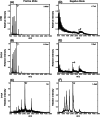Production and analysis of multiply charged negative ions by liquid atmospheric pressure matrix-assisted laser desorption/ionization mass spectrometry
- PMID: 30067883
- PMCID: PMC7757204
- DOI: 10.1002/rcm.8246
Production and analysis of multiply charged negative ions by liquid atmospheric pressure matrix-assisted laser desorption/ionization mass spectrometry
Abstract
Rationale: Liquid atmospheric pressure matrix-assisted laser desorption/ionisation (AP-MALDI) has been shown to enable the production of electrospray ionisation (ESI)-like multiply charged analyte ions with little sample consumption and long-lasting, robust ion yield for sensitive analysis by mass spectrometry (MS). Previous reports have focused on positive ion production. Here, we report an initial optimisation of liquid AP-MALDI for ESI-like negative ion production and its application to the analysis of peptides/proteins, DNA and lipids.
Methods: The instrumentation employed for this study is identical to that of earlier liquid AP-MALDI MS studies for positive analyte ion production with a simple non-commercial AP ion source that is attached to a Waters Synapt G2-Si mass spectrometer and incorporates a heated ion transfer tube. The preparation of liquid MALDI matrices is similar to positive ion mode analysis but has been adjusted for negative ion mode by changing the chromophore to 3-aminoquinoline and 9-aminoacridine for further improvements.
Results: For DNA, liquid AP-MALDI MS analysis benefited from switching to 9-aminoacridine-based MALDI samples and the negative ion mode, increasing the number of charges by up to a factor of 2 and the analyte ion signal intensities by more than 10-fold compared with the positive ion mode. The limit of detection was recorded at around 10 fmol for ATGCAT. For lipids, negative ion mode analysis provided a fully orthogonal set of detected lipids.
Conclusions: Negative ion mode is a sensitive alternative to positive ion mode in liquid AP-MALDI MS analysis. In particular, the analysis of lipids and DNA benefited from the complementarity of the detected lipid species and the vastly greater DNA ion signal intensities in negative ion mode.
© 2018 The Authors. Rapid Communications in Mass Spectrometry Published by John Wiley & Sons Ltd.
Figures




References
Grants and funding
LinkOut - more resources
Full Text Sources
Other Literature Sources
